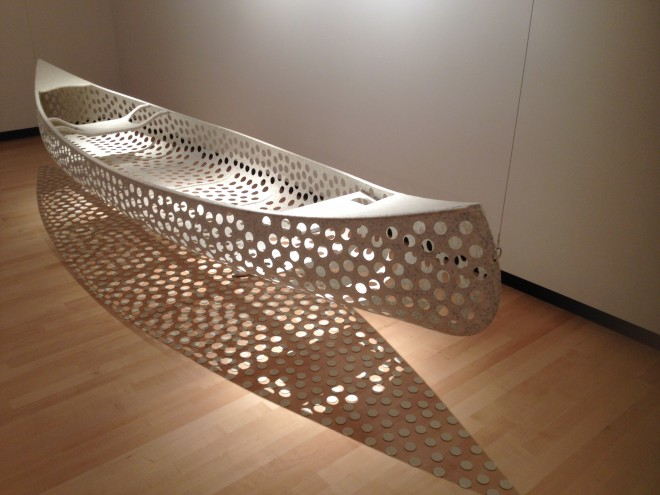While you're out and about this Spring enjoying the less freezing cold temperatures stop by the Burchfield Penney Art Center at SUNY Buffalo State and check out The Scrutiny of Objects: Sculptures By Robert A. Booth. The press release, found at www.burchfieldpenney.org, gives you a context for the art...
"In 1914 the artist Marcel Duchamp began using what appeared to be ordinary manufactured objects to create sculpture. These “readymade” works elevated ordinary objects to the dignity of art. Around the same time the First World War brought new developments in the art of camouflage. Razzle Dazzle techniques were used to confuse attackers in battles at sea. On land, artists painted their own designs onto cannons and embattlements to hide them from enemy attack. A century later, sculptor Robert Booth uses some if these same techniques to transform everyday objects into works of art."
The exhibition is on view in the Sylvia L. Rosen Gallery on the second floor from March 13 to August 30, 2015. My gut reaction was: "damn, I got to step up my game!" (I'm a painter and sculptor too). First off, the space is beautiful... it's a tad small but it has a skylight in the center of the room and a balcony overlooking the main gallery on the first floor. The work, like the space, is clean, contemplative, and fresh. Compared to Booth's figurative sculptures of the recent past, this new work is simpler and minimal. His figurative works, are provocative and packed with allegory. They are imbued with pathos and humor and assert a handmade aesthetic. His new works on the other hand, have more of a conceptual slant and relish in the simple pleasure of shapes, forms, and contours of everyday objects. These works are tediously mummified in small strips of masking tape transforming the utilitarian objects into sacred works of art, or as the press release implies, camouflaging them as a strategy to disable our automatic categorization of these objects in terms of their use. I also find interesting how each piece is mounted to painted rectangles on the wall, or in the case of "Canoe (Float)" and "Lawnmower (Cut)" framed by pieces of tape on the floor. Perhaps this is another tactic to distance our familiarity with these objects; by framing something the thing becomes elevated to high art.
The sculpture with the most impact in the show is "Canoe (Float)". It's both cute and terrifying. By Booth cutting polka dot shaped holes throughout the entire surface of the canoe and suspending it from the ceiling to give it an appearance of being afloat the viewer is thrust down upon a razor thin divide between the utilitarian and the aesthetic. The viewer is stimulated by the contrast of what we see with our eyes and what we see with our brain; or more specifically between the way it hovers there in mid air with beams of light pouring out each perfectly round circle dazzling the floor beneath it and the thought of being in that canoe on a lake sinking fast.

